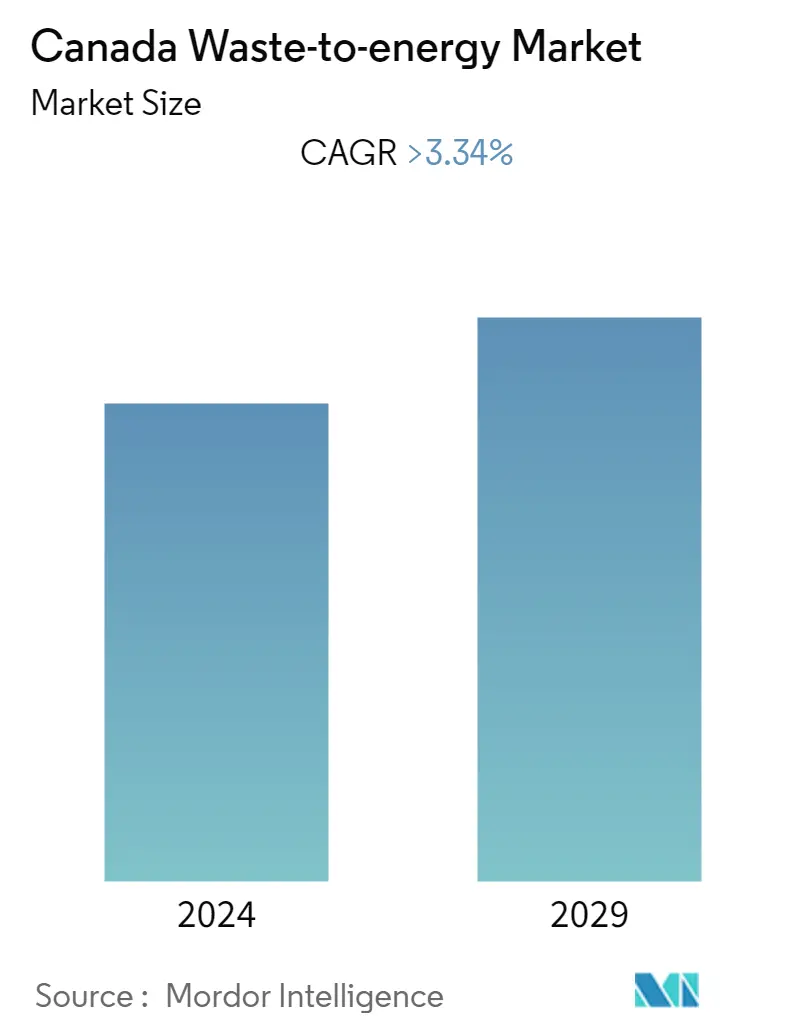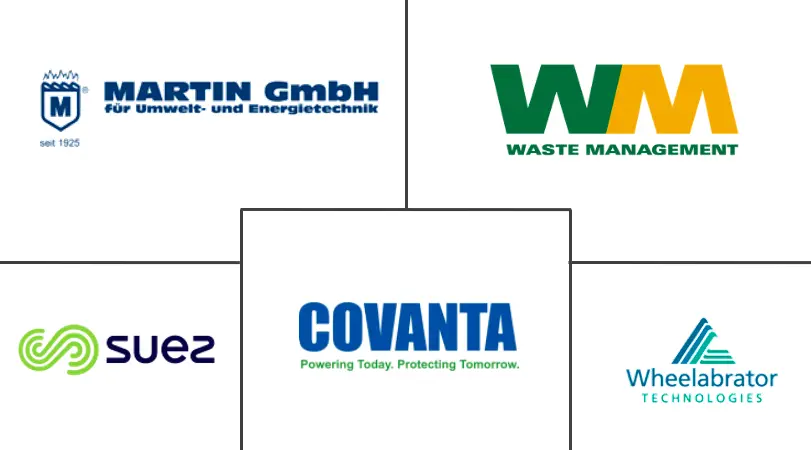Market Size of Canada Waste-to-energy Industry

| Study Period | 2019 - 2029 |
| Base Year For Estimation | 2023 |
| Forecast Data Period | 2024 - 2029 |
| Historical Data Period | 2019 - 2022 |
| CAGR | > 3.34 % |
| Market Concentration | Medium |
Major Players
*Disclaimer: Major Players sorted in no particular order |
Canada Waste to Energy Market Analysis
Canada's waste-to-energy market is expected to register a CAGR of more than 3.34% during the forecast period.
The outbreak of COVID-19 had a negative effect on the market. Currently, the market has rebounded to pre-pandemic levels.
- Canada has been one of the countries worldwide at the forefront of adopting WTE technologies, mainly because of the introduction of many favorable government initiatives.
- The country still lacks suitable policies and regulations concerning WTE, high capital investment, an increasing rate of recycling waste, and several other factors that have been restraining the growth of the WTE market.
- Technological advancements in the waste-to-energy sector are expected to create significant opportunities for plant operators in the near future. Municipalities in the state have moved toward both public and private companies to meet budget constraints and increase efficiency in managing WTE technologies.
Canada Waste to Energy Industry Segmentation
Waste-to-energy is the process of generating energy in the form of electricity and/or heat through the primary treatment of waste or the processing of the same into a fuel source. The technology used for this process includes physical, thermal, and biological technologies. The Canadian waste-to-energy market is segmented by technology into physical technology, thermal technology, and biological technology. For each segment, market sizing and forecasts have been done based on revenue (USD billion).
Canada Waste-to-energy Market Size Summary
Canada's waste-to-energy (WTE) market is experiencing a resurgence, rebounding to pre-pandemic levels after the negative impact of COVID-19. The country has been a leader in adopting WTE technologies, supported by favorable government initiatives. However, challenges such as the lack of suitable policies, high capital investment requirements, and an increasing rate of recycling waste have been hindering market growth. Technological advancements in the sector are poised to offer significant opportunities for plant operators, with municipalities collaborating with both public and private entities to enhance efficiency and manage budget constraints. The thermal process, which includes methods like plasma arc gasification and pyrolysis, is central to WTE technologies, with incineration being the most recognized method for processing municipal solid waste. Despite its efficiency, incineration faces scrutiny due to pollution and health risks, prompting the adoption of emission-reducing technologies.
The market landscape in Canada is moderately fragmented, with key players such as Martin GmbH, Suez SA, Covanta Holding Corp., Waste Management Inc., and Wheelabrator Technologies Inc. actively participating. Recent developments include significant investments and the commissioning of new plants, such as the one in Meadow Lake, Saskatchewan, which aims to provide power and heat to local communities. However, the market's growth is expected to be tempered by stringent carbon emission regulations and a strong focus on increasing recycling rates. These factors, combined with the availability of advanced recycling technologies and supportive government policies, are likely to influence the trajectory of Canada's waste-to-energy market in the coming years.
Canada Waste-to-energy Market Size - Table of Contents
-
1. MARKET OVERVIEW
-
1.1 Introduction
-
1.2 Market Size and Demand Forecast in USD billion, till 2028
-
1.3 Recent Trends and Developments
-
1.4 Government Policies and Regulations
-
1.5 Market Dynamics
-
1.5.1 Drivers
-
1.5.2 Restraints
-
-
1.6 Supply Chain Analysis
-
1.7 PESTLE Analysis
-
-
2. MARKET SEGMENTATION BY TECHNOLOGY
-
2.1 Physical Technology
-
2.2 Thermal Technology
-
2.3 Biological Technology
-
Canada Waste-to-energy Market Size FAQs
What is the current Canada Waste-to-energy Market size?
The Canada Waste-to-energy Market is projected to register a CAGR of greater than 3.34% during the forecast period (2024-2029)
Who are the key players in Canada Waste-to-energy Market?
Covanta Holding Corp, Martin GmbH, Suez SA, Waste Management, Inc and Wheelabrator Technologies Inc are the major companies operating in the Canada Waste-to-energy Market.

